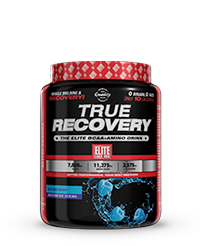
Start incorporating higher rep schemes into your workout to experience explosive new muscle growth!
Ronnie Coleman, 8x Mr. Olympia, once said, “Everybody wants to be a bodybuilder, but don’t nobody want to lift no heavy ass weight.”
It’s long been believed that heavier weights are best for building muscle. And if you want to “tone” and increase muscle endurance, you use lighter weights.
But a growing body of research disagrees, and proves you can build just as much muscle lifting lighter weights for higher reps as you can with “heavy-ass weight.”
The Research
According to multiple studies, including a large meta-analysis, lifting lighter weights for higher reps builds the same amount of muscle as heavier weights for fewer reps when sets are taken to muscle failure. So let’s take a look at those studies.
In an initial study published in the Journal of Applied Physiology (July, 2012) researchers had 18 male subjects train their legs on a leg extension machine 3 times a week for 10 weeks. Group one used 30% of their 1-rep max until they reached muscle failure between 30-40 reps. Group 2 lifted heavier, using 80% of their 1-rep max and reaching failure between 8-12 reps.
At the end of this study, both groups experienced nearly identical increases in lean muscle growth.1 But this study had one major flaw. The subjects didn’t have any experience with weight training, and most newbies will grow no matter what they do at first.
So in a follow-up study published in 2016, 49 resistance-trained men performed full-body workouts 3 times a week for 12 weeks. Group one used 30-50% of their 1-rep max, which allowed them to complete between 20-25 reps. Group 2 used 75-90% of their 1-rep max, which allowed them reach muscle failure between 8-12 reps.
At the end of those 12 weeks, both groups gained the SAME amount of lean muscle mass! In addition, they experienced an increase in the size of their Type 1 and Type 2 muscle fibers. And both groups experienced a significant increase in their 1-rep max.2
If that’s not enough to convince you, a third study published in the Journal of Strength and Conditioning (Oct. 2015) found similar results. 18 experienced resistance-trained men were assigned to one of two groups for 8 weeks where they performed a full-body routine 3 time per week.
Group 1 lifted a light load, reaching muscle failure around 25-35 reps. Group 2 lifted a heavy load, reaching muscle failure at 8-12 reps. At the end of the 8 weeks, both groups packed on the same amount of lean muscle mass, with significant increases in the biceps, triceps, and quadriceps.3
Why Are High Reps So Effective?
Researchers believe that muscle growth occurs through one of two means. The first is mechanical stress, which happens when you stress the muscle fibers with a heavy load. Those muscle fibers break down and sustain micro tears which then need to be rebuilt.
The second is metabolic stress, where the muscle becomes stressed by the accumulation of metabolic by-products. Think lactic acid.
Through both mechanisms, muscle protein synthesis is stimulated, which is why both approaches create a similar muscle growth response.
The Key to Making High Reps Work
As mentioned above, the key to building big muscle with lighter weight is to take each set to failure. This method will burn. It won’t feel comfortable. Especially the higher in reps you go. So when you feel that burn, don’t stop. Keep fighting through, and take your sets all the way to muscle failure.
So should I ditch heavy weights altogether?
Probably not. One thing that’s important to note is this. Although researchers found that both light and heavy weights can lead to similar increases in muscle size, ultimately, lifting heavy weights is superior for maximizing strength.3 Which seems like a no-brainer, right? Totally makes sense.
Now, if you’re only concerned with muscle aesthetics and don’t care so much for strength, you can make the switch to working with lighter weights. Save your joints some grief. But if you want your muscles to be as strong as they actually look, it’s a good idea to keep both heavy and light weights in your routine.
So, how do you go about doing that? Let’s look at a few different ways that you can incorporate lighter weights into your routine to ignite new muscle growth.
The first way is to use a Linear Periodization scheme, where each week you will use progressively heavier loads for fewer reps. An example might look like this.
Phase 1
Week 1: 25-30 reps
Week 2: 20-25 reps
Week 3: 15-20 reps
Week 4: 12-15 reps
Week 5: 9-11 reps
Week 6: 6-8 reps
At the end of week 6, you’ll start week 1 all over again and work with 25-30 reps. And what you’ll find is you’re able to use more weight for more reps, thanks to the strength adaptations that take place.
You can also condense this into a 4 week plan.
Week 1: 21-30 reps
Week 2: 15-20 reps
Week 3: 10-14 reps
Week 4: 6-9 reps
Another way to incorporate high reps into your workout is do both low and high reps on the same day. Using chest as an example, your chest workout might look like this.
3x Barbell Bench Press: 6-8 reps
3x Decline Hammer Strength Press: 9-11 reps
3x Incline Dumbbell Flyes: 15-20 reps
3x Cable Crossovers: 21-30 reps
A third option is to use intensity techniques such as drop sets on the LAST 1-2 sets of an exercise. For example, let’s say you’re doing Incline Dumbbell Presses using 90 lb dumbbells for 10 reps. When you reach muscle failure, you’ll immediately set the 90 lb dumbbells down and grab a weight that is 40% lighter. In this case, you’ll reach for the 55 lb dumbbells and continue repping out until you hit muscle failure again.
The first set will stress your muscles mechanically, and the second set will stress your muscles metabolically.
So there you have it. Apply these ideas and strategies to your workouts and enjoy some explosive new muscle growth! No “heavy-ass weight” needed!
References
Phillips, et al. Resistance exercise load does not determine training mediated hypertrophic gains in young men. Journal of Applied Physiology (July 2012). https://www.ncbi.nlm.nih.gov/pmc/articles/PMC3404827/
Phillips, SM., et al. Neither load nor systemic hormones determine resistance training-mediated hypertrophy or strength gains in resistance-trained young men. Journal of Applied Physiology (July 2016). https://www.ncbi.nlm.nih.gov/pubmed/27174923
Schoenfeld, BJ., et al. Effects of Low- vs. High-Load Resistance Training on Muscle Strength and Hypertrophy in Well-Trained Men. Journal of Strength and Conditioning. Oct. 2015. https://www.ncbi.nlm.nih.gov/pubmed/25853914
Elite Labs
Average rating: 0 reviews






